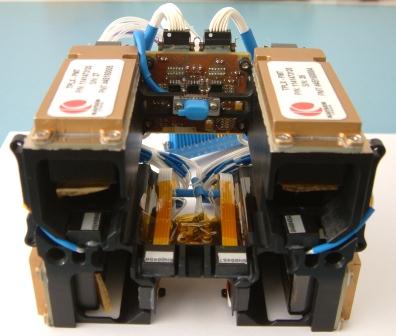 Biological sample: TRIPLELUX investigates immune system cells and bacteria. Three different experiments on Vertebrates and Invertebrates phagocytes, i.e. Rodent macrophages and Mytilus edulis haemocytes are respectively involved in TRIPLELUX-A and B, while recombinant Salmonella typhimurium strains is investigated in TRIPLELUX-C.
Biological sample: TRIPLELUX investigates immune system cells and bacteria. Three different experiments on Vertebrates and Invertebrates phagocytes, i.e. Rodent macrophages and Mytilus edulis haemocytes are respectively involved in TRIPLELUX-A and B, while recombinant Salmonella typhimurium strains is investigated in TRIPLELUX-C.
TRIPLELUX experiment: Rodent macrophages and Mytilus edulis haemocytes cultures in liquid media are required by the scientists to study how spaceflight conditions (cosmic ray) affect phagocytosis, a main process for immune system cell. A Salmonella typhimurium culture in liquid media is also required by the scientists to investigate the aggravation of radiation responses in microgravity (cosmic ray and artificial radiation). In both experiments, cellular reaction is mediated by light emission. In TRIPLELUX-A and B by means of a so called Activator, the phagocytosis process is triggered. Oxidizing agents released by the activated cells react with a proper substrate emitting chemo-luminescence.
In TRIPLELUX-C genetically modified bacteria react to radiation and other agents that induce DNA damages with a dose dependent measurable emission of bioluminescence. The chemo-luminescence or bioluminescence signal of cellular response is detectable by TRIPLELUX hardware hence, it operates as a biosensor.
Hardware performance: The TRIPLELUX EHW is designed to act as a biosensor. The behaviour of immune cells and bacteria cultures in liquid media is detectable into four analytical chambers where chemo/bio-luminescence measurements are carried out by a photomultiplier. Optical density measurement to assess sample concentration, and UV treatment takes place in TRIPLELUX “C” hardware by means of OD-measurement LEDs and UV-LEDs. The three experiments are performed by the same hardware with minor modifications. The scientific protocol is largely capable of being changed, as the hardware design fits different biological samples and protocols can be planned with respect to timeline, volumes, temperatures, sample treatments etc. Validation by the so called control experiment, or by replica comparison is also provided.